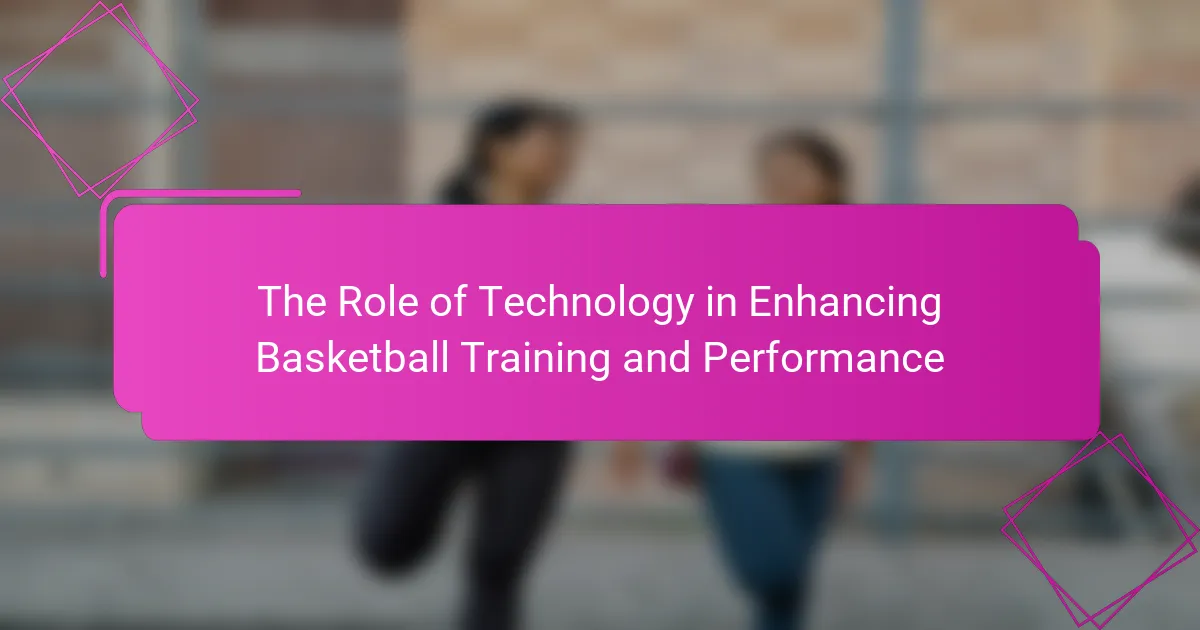Technology significantly enhances basketball training and performance by providing data analytics, wearable devices, and virtual reality tools. These innovations enable tailored training programs, improve injury prevention, and optimize game strategies. By integrating advanced analytics and immersive training environments, players can refine skills and enhance decision-making. This article explores how these technologies transform player development and team performance across various skill levels.

How is technology transforming basketball training and performance?
Technology is revolutionising basketball training and performance through data analytics, wearable devices, and virtual reality. These innovations enhance player development, improve injury prevention, and optimise game strategies.
Data analytics provides insights into player performance, allowing coaches to tailor training programmes. Wearable devices track metrics like heart rate and movement patterns, helping athletes monitor their physical condition. Virtual reality simulations create immersive training environments, improving decision-making skills and situational awareness.
The integration of these technologies leads to more personalised training regimens, ultimately enhancing overall team performance. As a result, players can achieve their peak potential more efficiently.
What are the key technological innovations in basketball training?
Key technological innovations in basketball training include wearable devices, video analysis software, virtual reality, shooting machines, and analytics platforms. These tools enhance performance by providing real-time feedback and personalised training programmes. Wearable devices track player metrics like heart rate and movement patterns, while video analysis allows coaches to dissect gameplay and improve strategies. Virtual reality immerses players in game-like scenarios for better decision-making. Shooting machines automate practice sessions, ensuring consistent shooting technique. Analytics platforms analyse player performance data to identify strengths and weaknesses, guiding targeted training approaches.
How do wearable devices enhance player performance analysis?
Wearable devices enhance player performance analysis by providing real-time data on various metrics. These devices track heart rate, movement patterns, and fatigue levels, allowing coaches to make informed training decisions. They also offer insights into player biomechanics, which can improve technique and reduce injury risk. By analysing this data, teams can tailor training programmes to individual needs, maximising performance and efficiency.
What role do video analytics play in coaching strategies?
Video analytics significantly enhance coaching strategies by providing data-driven insights into player performance and team dynamics. Coaches utilise video analytics to assess player movements, decision-making, and overall game strategies. This technology allows for detailed breakdowns of gameplay, enabling targeted feedback and personalised training plans.
For example, analysing shot accuracy and defensive positioning can help identify areas for improvement. Additionally, video analytics facilitate the comparison of player performance over time, fostering continuous development. Coaches can also simulate game scenarios using analytics, improving strategic planning and in-game adjustments. Overall, integrating video analytics into coaching enhances training effectiveness and optimises team performance.
How is virtual reality being utilised in skill development?
Virtual reality enhances skill development in basketball by providing immersive training experiences. It allows players to simulate game scenarios, improve decision-making, and refine techniques in a controlled environment. This technology offers real-time feedback, enabling athletes to analyse their performance and make necessary adjustments. Additionally, VR can create unique training situations that are rarely available in traditional practice, such as facing virtual opponents with varying skill levels. As a result, players can experience diverse challenges that promote adaptability and skill acquisition.
Which mobile applications are most effective for basketball training?
Mobile applications like HomeCourt, DribbleUp, and Basketball Coach are highly effective for basketball training. These apps utilise technology to enhance skills, track performance, and provide personalised feedback. HomeCourt uses AI to analyse shooting form and offer drills, while DribbleUp focuses on ball-handling exercises with augmented reality. Basketball Coach provides playbook creation and training plans. Each app’s unique features cater to different training needs, making them valuable tools for players at all levels.

What are the benefits of integrating technology into basketball training?
Integrating technology into basketball training enhances performance through improved analytics, personalised feedback, and advanced training tools. These innovations help athletes refine skills, track progress, and reduce injury risks.
Wearable technology, such as fitness trackers, provides real-time data on player performance metrics like heart rate and movement patterns. This data allows coaches to tailor training programmes to individual needs.
Video analysis software offers insights into techniques and strategies, enabling players to visualise their performance. This technology helps identify areas for improvement and fosters better decision-making on the court.
Virtual reality training systems immerse players in game-like scenarios, enhancing their reaction times and situational awareness. This unique training method prepares athletes for high-pressure situations during actual games.
How does technology improve player feedback and motivation?
Technology significantly enhances player feedback and motivation through real-time data analytics and interactive training tools. Wearable devices track performance metrics, providing instant insights that help athletes identify strengths and areas for improvement. Gamified training applications engage players by incorporating competitive elements, fostering motivation to achieve personal bests. Virtual reality simulations create immersive experiences, allowing athletes to practice in various scenarios, boosting confidence and skill retention. Overall, these technological advancements create a more engaging and effective training environment, ultimately enhancing basketball performance.
What impact does data-driven training have on performance outcomes?
Data-driven training significantly enhances basketball performance outcomes by utilising analytics to inform coaching strategies. This approach allows for personalised training regimens based on player performance metrics. For instance, tracking shooting accuracy, movement patterns, and fatigue levels enables coaches to tailor drills effectively. As a result, athletes can focus on areas that require improvement, leading to better overall performance on the court. Data-driven insights also foster accountability, motivating players to meet specific performance goals and benchmarks.
How can technology facilitate injury prevention and recovery?
Technology enhances injury prevention and recovery in basketball through various innovative tools. Wearable devices monitor player biomechanics, providing real-time feedback to prevent injuries. Advanced analytics identify risk factors, allowing coaches to tailor training regimens. Virtual reality aids in rehabilitation, simulating game scenarios for mental recovery. Mobile apps track recovery progress, ensuring adherence to rehabilitation protocols. These technologies collectively improve player safety and performance on the court.

Which challenges do teams face when adopting new technologies?
Teams face several challenges when adopting new technologies in basketball training. Resistance to change is common, as players and coaches may be accustomed to traditional methods. Training staff may lack the technical expertise to implement new systems effectively. Additionally, integrating technology with existing training regimens can be complex, often requiring adjustments to workflows. Budget constraints may limit access to advanced tools, and data overload can overwhelm teams, making it difficult to extract actionable insights. Lastly, ensuring consistent usage among all team members is crucial for success.
What are the common barriers to technology implementation in basketball?
Common barriers to technology implementation in basketball include high costs, lack of training, resistance to change, and insufficient infrastructure. These factors hinder effective integration of advanced tools for training and performance enhancement. For example, budget constraints can limit access to cutting-edge analytics software or wearable technology. Additionally, coaches and players may resist adopting new methods due to familiarity with traditional practices.
How do budget constraints affect technology adoption in teams?
Budget constraints can significantly limit technology adoption in basketball training teams. Limited funds restrict access to advanced training tools and software, impacting overall performance enhancement. Teams may prioritise essential resources over innovative technologies, resulting in slower progress. Additionally, budget limitations can hinder ongoing training and support for new technologies, reducing their effectiveness.
Which training environments are most conducive to technology use?
Training environments that promote effective technology use in basketball include gyms equipped with advanced analytics tools, outdoor courts with mobile applications, and training facilities that integrate virtual reality. These settings enhance player performance through real-time feedback and data analysis. Technology thrives in environments where athletes can easily access performance metrics and engage in interactive training methods. For example, dedicated training centres with specialised equipment can significantly elevate the training experience.

How can technology be tailored to different levels of play?
Technology can be tailored to different levels of play by offering customised training programmes and performance analytics. Advanced tools, such as wearable sensors and video analysis software, adapt to individual skill levels, providing targeted feedback and drills. For beginners, technology can simplify concepts and focus on fundamental skills. Intermediate players benefit from performance metrics to refine techniques. Elite athletes utilise sophisticated data analytics for strategy optimisation and injury prevention. This tailored approach enhances learning and performance across all levels of basketball training.
What specific tools are recommended for youth basketball training?
Recommended tools for youth basketball training include shooting machines, performance analysis software, and wearable technology. These tools enhance skill development, track progress, and provide real-time feedback. For example, shooting machines automate shot repetition, while performance analysis software offers insights into player metrics. Wearable technology monitors physical exertion and biomechanics, helping coaches tailor training programmes.
How do professional teams leverage advanced analytics differently?
Professional teams leverage advanced analytics to gain competitive advantages through tailored performance insights. They utilise data to evaluate player efficiency, optimise training regimens, and enhance game strategies. By integrating technology like wearables and video analysis, teams can analyse biomechanics and decision-making processes in real-time. This approach allows for personalised training interventions that target unique player attributes, such as shooting accuracy or defensive agility. Additionally, teams increasingly employ predictive analytics to forecast player performance and injury risks, ensuring more informed decisions in player management.

Which emerging technologies are set to impact basketball training in the future?
Emerging technologies such as artificial intelligence, wearables, and virtual reality are set to significantly impact basketball training. AI can analyse player performance data to provide personalised training regimens. Wearable technology tracks metrics like heart rate and movement, offering insights into physical condition. Virtual reality creates immersive training environments, enhancing skill acquisition and game strategy understanding. These technologies collectively enhance training efficiency and player performance.
How might artificial intelligence change coaching methods?
Artificial intelligence can transform coaching methods by providing personalised training experiences. AI analyses player performance data, offering tailored feedback and strategies. This data-driven approach enhances skill development and decision-making during games. Coaches can utilise AI to simulate game scenarios, improving players’ tactical understanding. Additionally, AI can track player health metrics, ensuring optimal training loads and reducing injury risks.
What potential does augmented reality hold for player engagement?
Augmented reality significantly enhances player engagement by offering immersive training experiences. It allows athletes to visualise complex plays, improving their understanding of game strategies. Additionally, AR can simulate real-game scenarios, providing instant feedback on performance. This technology fosters a deeper connection between players and the game, ultimately enhancing their skills and enjoyment.
Which trends in sports technology should basketball coaches be aware of?
Basketball coaches should be aware of trends such as data analytics, wearable technology, virtual reality, and artificial intelligence. These innovations enhance training, improve player performance, and provide insights into game strategies.
Data analytics allows coaches to track player statistics and performance metrics, leading to informed decision-making. Wearable technology, like fitness trackers, monitors players’ physical conditions in real-time, optimising training regimens. Virtual reality offers immersive training experiences, enabling players to practice scenarios without physical strain. Artificial intelligence analyses game footage, identifying patterns and suggesting tactical adjustments.
Staying updated on these trends helps coaches create more effective training programmes and enhance team performance.

What best practices should teams follow when implementing technology in training?
Teams should prioritise user-friendly technology, clear training objectives, and continuous feedback when implementing technology in basketball training. Effective integration enhances performance and engagement.
1. Choose intuitive technology that players can easily navigate.
2. Define specific training goals to align technology use with performance improvement.
3. Incorporate regular feedback sessions to assess technology effectiveness.
4. Ensure ongoing training for coaches and players to maximise technology benefits.
How can coaches effectively integrate technology into their training regimens?
Coaches can effectively integrate technology into their training regimens by utilising performance analytics, wearable devices, and video analysis. These tools enhance player development and improve team strategies.
Performance analytics provide data-driven insights into player performance, allowing coaches to tailor training sessions to individual needs. Wearable devices track metrics such as heart rate and movement patterns, offering real-time feedback on athlete condition and effort levels. Video analysis enables coaches to review gameplay, identify areas for improvement, and enhance tactical understanding.
As a result, incorporating technology fosters a more personalised training environment, ultimately leading to better performance outcomes.
What common mistakes should teams avoid when adopting new tools?
Teams should avoid common mistakes like inadequate training and resistance to change when adopting new tools. Failing to provide proper training can lead to underutilisation of technology, diminishing its potential benefits for basketball performance. Resistance to change can hinder team dynamics and slow down the integration process. Additionally, neglecting to align new tools with existing workflows may result in inefficiencies. Lastly, overlooking feedback from team members can prevent necessary adjustments, ultimately impacting the effectiveness of the tools.
Which strategies enhance player buy-in for technology use?
Integrating technology into basketball training enhances player buy-in through engagement, personalisation, and measurable progress. Players respond positively to interactive tools, such as virtual reality training and performance analytics. These technologies provide instant feedback and tailored training plans, increasing motivation and commitment. Regular updates and gamified elements further sustain interest and participation.
